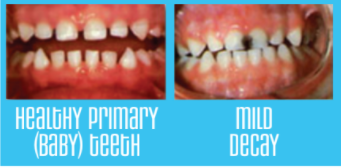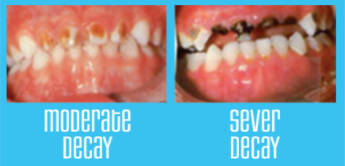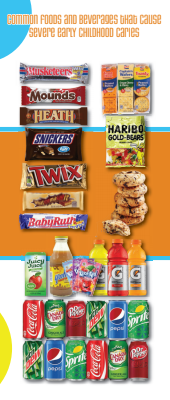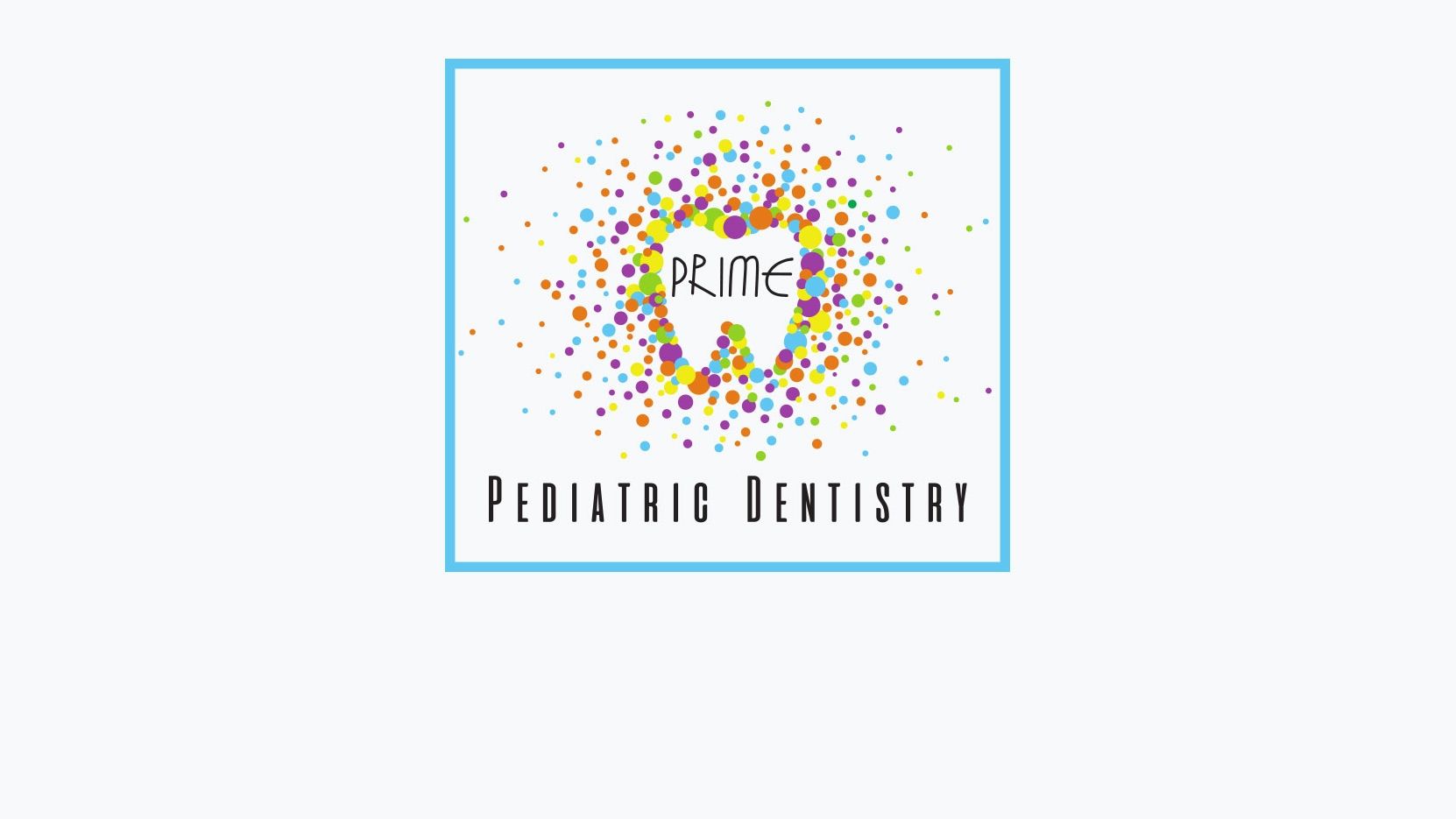EARLY CHILDHOOD CARIES
WHAT CAUSES EARLY CHILDHOOD CARIES?
Early Childhood Caries is defined as the presence of one or more decayed Surgical intervention is usually required to appropriately treat early The American Academy of Pediatric Dentistry encourages professional and at-home preventive measures that include:
(non cavitated or cavitated lesions), missing (due to caries), or filled tooth surfaces in any primary tooth in a child under the age of six. ECC was formerly referred to as nursing bottle caries, nursing caries, and baby bottle tooth decay. Dental caries is the most common chronic disease of childhood. [above asthma, common cold, diabetes, etc]
WHAT IS SEVERE EARLY CHILDHOOD CARIES?
The definition of Severe Early Childhood Caries is any sign of smooth-surface cavities in a child younger than three years of age, and from ages three through five is: one or more cavitated teeth, missing teeth (due to cavities), or presence of smooth surface cavities on upper front teeth.
HOW IS EARLY CHILDHOOD CARIES TREATED?
Surgical intervention is usually required to appropriately treat early childhood caries. Patients undergo Full Mouth Oral Rehabilitation in a hospital setting. Full Mouth Oral Rehabilitation includes:
- General Anesthesia via IV [intravenous access] and breathing tube.
- Taking radiographs [if unable to collect in office]
- Creating a full treatment plan based on the condition of teeth and a full set of radiographs.
- Executing and completing treatment plan of fillings, extractions, crowns, baby root canals, etc. in the hospital.
- Identify and notify ALL CAREGIVERS of proper diet and hygiene that reduces the risk of cavities. Correct any habits that contribute to a high cavity risk.
- 1 week follow up after surgery is completed.
- 3 Month Recall to ensure proper diet and oral hygiene have been satisfied.
- If 3 Month Recall is successful, then the next visit will be the typical 6 Month
Cleaning Visit.
If it is determined that your child still has a poor diet, poor hygiene, and at-home oral hygiene regimen, then 3 Month Recall Visits will be continued until proper diet and hygiene are achieved.
REDUCING THE RISK OF EARLY CHILDHOOD CARIES
- Avoiding frequent consumption of liquids and/or solid foods containing sugar, in particular: • Sugar-sweetened beverages (e.g., juices, soft drinks, sports drinks, sweetened tea) in a baby bottle or no-spill training cup. • At-will breast-feeding after the first primary tooth begins to erupt and other dietary carbohydrates are introduced. • Baby bottle use after 12-18 months.
- Implementing oral hygiene measures no later than the time of eruption of the first primary tooth. Toothbrushing should be performed for children by a parent twice daily, using a soft toothbrush of age-appropriate size. In children under the age of three, a smear or rice-sized amount of fluoridated toothpaste should be used. In children ages three to six, a pea-sized amount of fluoridated toothpaste should be used.
- Providing professionally-applied fluoride varnish treatments for children at risk for ECC.
- Establishing a dental home within six months of the eruption of the first tooth and no later than 12 months of age to conduct a caries risk assessment and provide parental education including anticipatory guidance for prevention of oral diseases.
- Working with medical providers to ensure all infants and toddlers have access to dental screenings, counseling, and preventive procedures.
- Dilute juice with water. Hide the actual juice container, replacing it with a pitcher.
- Allow your child to have no more than 6 ounces of juice a day.
REDUCING THE RISK OF EARLY CHILDHOOD CARIES (cont’)


CLASSIFICATION OF EARLY CHILDHOOD CARIES MILD
- Existence of isolated carious lesion involving molars and incisors.
- number of carious teeth increases as the cariogenic challenge increases.
- cause is usually a combination of semisolid cariogenic food and lack of oral hygiene.
- Usually seen in children 2-5 years old
MODERATE
- Smooth surface cavities affecting upper teeth.
- Lower incisors are not affected.
- Use of a feeding bottle or at will breast-feeding, or a combination of both with or without proper hygiene.
- Seen soon after the tooth eruption.
SEVERE
- Cavities affecting all teeth including mandibular incisors.
- cause is food that is prone to causing cavities and poor oral hygiene.
- Conditions are rampant.
WHAT CAUSES EARLY CHILDHOOD CARIES?
- Poor oral hygiene
- Nighttime bottle feeding with juice and/ or milk [including flavored milk]
- Repeated use of a sippy or no-spill cup with a sweetened beverage
- Frequent in-between meal consumption of sugar-added snacks or drinks (e.g., juice, formula, soda, cookies, crackers, etc)
- Frequent nighttime bottle-feeding with milk and at will breastfeeding for pleasure [not for nutrition]





